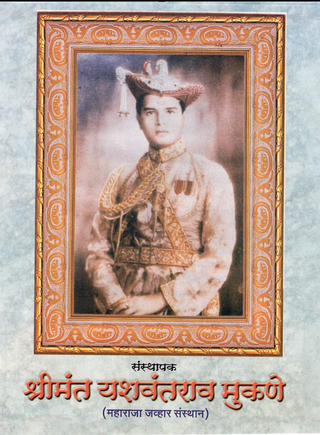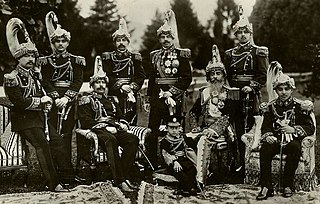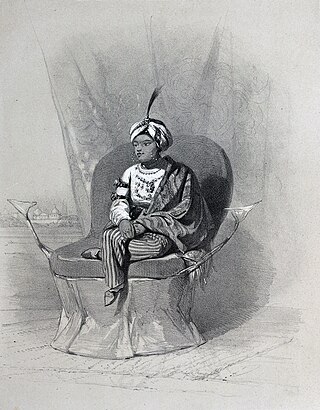Related Research Articles

Mahārāja is a Sanskrit title for a "great ruler", "great king" or "high king".

The Most Eminent Order of the Indian Empire is an order of chivalry founded by Queen Victoria on 1 January 1878. The Order includes members of three classes:
- Knight Grand Commander (GCIE)
- Knight Commander (KCIE)
- Companion (CIE)

Cooch Behar, also known as Koch Bihar, was a princely state in India during the British Raj. The state was placed under the Bengal States Agency, part of the Eastern States Agency of the Bengal Presidency. It is located south of the Himalayan kingdom of Bhutan, in present-day West Bengal.

Rana dynasty is a Chhetri dynasty that imposed totalitarianism in the Kingdom of Nepal from 1846 until 1951, reducing the Shah monarch to a figurehead and making Prime Minister and other government positions held by the Ranas hereditary. They claimed Kshatriya status themselves. Rana dynasty is historically known for the iron-fisted rule. This changed after the Revolution of 1951 with the promulgation of a new constitution, when power shifted back to the monarchy of King Tribhuvan.

The Bardhaman Raj, also known as Burdwan Raj, was a zamindari Raja estate that flourished from about 1657 to 1955 in the Indian state of West Bengal. Maharaja Sangam Rai Kapoor, a Khatri from Kotli, Punjab, who was the first member of the family to settle in Bardhaman, was the original founder of the house of Bardhaman, whereas his grandson Abu Rai, during whose time the zamindari started flourishing, is considered to be the patriarch of the Bardhaman Raj family.

Benares or Banaras State was a kingdom and later princely state in what is today Uttar Pradesh, India. On 15 October 1948, Benares' last ruler signed the accession to the Indian Union.

Jaipur State was a princely state in India during East India Company rule and thereafter under the British Raj. It signed a treaty creating a subsidiary alliance with the Company in 1818, after the Third Anglo-Maratha War. It acceded to independent India in 1947 and was integrated into India by 1949. Upon integration, the ruler was granted a pension, certain privileges, and the use of the title Maharaja of Jaipur by the Government of India. However, the pension, privileges, and the use of the title were ended in 1971 by the 26th Amendment to the Constitution of India.
The Darbhanga Raj, also known as Raj Darbhanga and the Khandwala dynasty, was a Maithil Brahmins dynasty and the rulers of territories, not all contiguous, that were part of the Mithila region, now divided between India and Nepal.

The Narayan dynasty was the ruling family of Benares. After its liberation from Awadh, independence (swaraj) was established in Benares by Maharaja Balwant Narayan Singh in the 18th century. Since then, the family has ruled Benares. In 1911, Benares became a full-fledged princely state of British India and the Narayan dynasty ruled it as British vassals until they acceded to independent India in 1947.
Prabhu Narayan Singh was ruler of the Benares State, an Indian princely state, from 1889 to 1931.
Maharaja Udit Narayan Singh was the eldest surviving son of Maharaj Mahip Narayan Singh, Udit Narayan Singh Sahib Bahadur became the new king of Benares. He was a nationalist and a benevolent ruler who refused to bow down against the anarchy and corruption of the company. He was even more averse to British dominion than his father and had regular confrontations with the company, who, in spite, falsely labeled him as an incapable administrator. He added grandeur to and formed the present shape of the world famous Ramlila of Ramnager which was a low key affair at that time. He like his father, did not levy taxes on farmers and he established checkpoints which took taxes according to the amount of goods which were taken to the city for selling and trading to encourage trade in finished goods, so as to check the drain of wealth from India. He was loved and revered by his people who established his statue at the Girija Bagh temple in PAC campus Ramnager. Britishers were not able to tolerate him, so conspired against him and under false charges confiscated all the lands of Benaras State and started ruthlessly exploiting the peasants. Unable to spectate it silently, the Maharaja, in 1828, petitioned the company to annul the 1794 agreement under which the Benaras State had lost the sarkars, and to press for their return to state control. However, the company, in accordance with its colonial intent, ordered a sham inquiry into Maharaj Udit Narayan Singh's personal affairs and his governance. As expected, the report backed the false charges of mismanagement. The company, taking advantage of its own fraud, confiscated the last remaining lands of the Maharaja and placed them under their own control which were sold into permanent settlement as Zamindaries. However the Maharaja purchased these Zamindaries back, from under the table, and had the last laugh. He built the first dam of UP for advancement of agriculture. Maharaja Udit Narayan Singh Saheb Bahadur ascended to Baikunth on 4 April 1835, aged 65, and was succeeded by his adopted son, Maharaja Ishwari Prasad Narayan Singh Sahib Bahadur.

Bharatpur State, which is also known as the Jat State of Bharatpur historically known as the Kingdom of Bharatpur, was a Hindu Kingdom in the northern part of the Indian subcontinent. It was ruled by the Sinsinwar clan of the Hindu Jats. At the time of reign of king Suraj Mal (1755–1763) revenue of the state was 17,500,000 rupees per annual.

The Sikh Rule in Lahore initiated from the invasion and rule of the Sikh Misls and extended till the Sikh Empire of Ranjit Singh which ended in 1849. The Sikhs began gaining power following the decline of the Mughal Empire in Punjab and consisted of a collection of autonomous Punjabi Misls, which were governed by Misldars, mainly in the Punjab region.

Orchha State was a kingdom situated in the Bundelkhand region and later a princely state in British India. The state was ruled by Bundela clan of Rajputs. It was located within what is now the state of Madhya Pradesh.

Jhalawar State was a princely state in India during the British Raj. It was located in the Hadoti region. The main town in the state was Jhalawar.

Kishangarh State was a princely state of India from 1611 to 1948. It was founded by the Jodhpur prince Kishan Singh in 1609. Prior to Kishan Singh this area was ruled by Raja Samokhan Singh.

Bakht Singh or Bakhat Singh was an 18th-century Indian Raja of the Rathore Clan. Born in 1706, he ruled over various domains in the Jodhpur and Marwar states and was a major political force during his life.
RajaVeer Fateh Bahadur Shahi was Raja of Huseypur Raj which is situated in today's Gopalganj district of Bihar in India.

Rafa'at wa Awal-i-Martabat Maharaja Sri Chait Singh Sahib Bahadur, commonly known as Chait Singh, was a ruler of Kingdom of Benares in northern India.

His Highness Maharaja Bahadur Sri Sir Ishwari Prasad Narayan Singh, GCSI was the Maharaja of Benares.He was belonging to Bhumihar brahmin family. He ascended the throne at the age of 13. During the Indian Rebellion of 1857, he remained neutral for the sake of his people, as he has not forgotten the treachery of his countrymen in the battle against Hastings. As a reward, he was promoted to the rank of Maharaja Bahadur in 1859. In 1867, he was granted a personal 13-gun salute; a decade later he was knighted with the GCSI, becoming Sir Ishwari. He eventually became a member of the Viceroy's Legislative Council, and in the crowning achievement of his reign, he restored all the family lands that had been lost for over a century.
References
- ↑ Bayly, C. A. (1988). Rulers, townsmen, and bazaars : north Indian society in the age of British expansion, 1770–1870 (1st pbk. ed.). Cambridge: Cambridge University Press. ISBN 0-521-31054-7. OCLC 20698220.
- ↑ Mukhopadhya, N (1872). Bharat Dharpan. Varanasi. pp. 60–75.